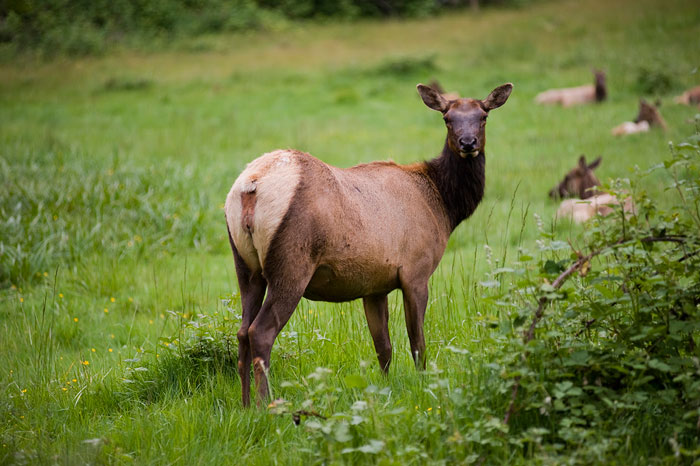- California Enduro Series Announces 2024 Schedule - 11/19/2023
- ASHLAND MOUNTAIN CHALLENGE 2023 – CES RACE REPORT - 10/04/2023
- China Peak Enduro 2023 – CES Race Report - 09/04/2023
Meet the cat who grew up along 1,600 miles of the PCT
By Caroline Tillman
 It was early morning on the Washington section of the Pacific Crest Trail (PCT), and Taylor St. John, a young woman with fiery dreadlocks, was just beginning to break down camp. “Manzanita!” she called into the woods as she stuffed her tent into her backpack. A few moments later, a striped gray kitten leapt out from the brush, sauntered towards her, and rubbed against her legs. For 1,300 miles, this feline had been keeping Taylor company on her thru-hike, riding atop her pack by day and killing mice in camp by night.
It was early morning on the Washington section of the Pacific Crest Trail (PCT), and Taylor St. John, a young woman with fiery dreadlocks, was just beginning to break down camp. “Manzanita!” she called into the woods as she stuffed her tent into her backpack. A few moments later, a striped gray kitten leapt out from the brush, sauntered towards her, and rubbed against her legs. For 1,300 miles, this feline had been keeping Taylor company on her thru-hike, riding atop her pack by day and killing mice in camp by night.
When Taylor began her hike at the Mexican border, she had already decided not to bring any pets along. The two cats she had adopted in her pre-trail life were safe and sound in Portland, where she had been living and working as a bartender for five years. Taylor didn’t think either of the cats were well trained enough to make the trip, and, as a first time thru-hiker, she thought it wiser to tackle the PCT without the additional stress of caring for an animal on trail.
370 miles into the southern California desert, however, long distance backpacking began to take its toll. Taylor started experiencing pain in her calves and ankles, so in order to heal, she took a few days off at a hiker friendly farm outside of Wrightwood. “I’d been at the farm for a few hours when someone told me there were five week old kittens living underneath the house,” she says, “I love cats, so it was natural for me to go find them.” Soon enough, she’d won over the kittens, but one, who she named Manzanita, was particularly friendly. “I got her to come out pretty regularly, and I would nap with her in my sleeping bag,” Taylor explains.

The farm owner told her that Manzanita’s mother typically has three litters a year, and most of the kittens are eaten by coyotes. Taylor was horrified at the idea of Manzanita succumbing to such a fate. She knew it would be impractical to hike with a cat, but Manzanita had formed such a close bond with her that the prospect didn’t seem unmanageable. Taylor decided to give it a shot. A friend built a box, similar to what vendors at baseball games wear, that tied around Taylor’s neck and waist and was capable of holding Manzanita. Armed with this makeshift kitten carrier and a three-pound bag of cat food, she set off down the trail with the kitten in tow.
Manzanita adapted to life on the trail surprisingly quickly. While Taylor hiked, Manzanita rested in the box around Taylor’s neck without many problems, and was vocal about expressing her needs. If Manzanita was thirsty, she pawed at Taylor’s water bottle. When Taylor snuck Manzanita into hostels or restaurants, the kitten seemed to know to keep quiet and stay hidden beneath her jacket. At night, if Manzanita had to relieve herself, she’d meow and Taylor would unzip her tent and Manzanita would dig a cat hole nearby before returning inside. “I honestly just feel like I got a really intelligent kitten, because I don’t think either of my cats at home would’ve been so easy to train, even when they were younger,” Taylor admits.
Nevertheless, hiking with a kitten had its challenges. Initially, Taylor was constantly nervous that a predator would attack Manzanita, and had to be vigilant about keeping her close at night. “I’d hear an owl in a tree, picture it swooping down and grabbing this tiny, teacup sized animal, and would ultimately pack up and go,” she says. During heat waves in the desert, Taylor was unable to walk for long periods of time during the middle of the day without Manzanita getting too hot. Instead, she’d sit in the shade and pour water over the kitten to cool her off. Given the cold temperatures, high snow year, and potential need to self-arrest in the Sierra, Taylor also had to skip 200 PCT miles, since she considered the conditions too dangerous for the cat.
 After a few months on the trail, Manzanita surpassed some of her earlier limitations. She outgrew her carrier and began to position herself on Taylor’s backpack or shoulders during hiking hours. In the evening when it got cooler, she’d often walk for five or ten miles, running ahead, climbing trees, and expertly scrambling over ice and loose rock. Instead of curling up next to Taylor, she braved the night in order to hunt mice and other small creatures — by the time they got to Washington, Taylor only had to carry one pound of cat food as a result.
After a few months on the trail, Manzanita surpassed some of her earlier limitations. She outgrew her carrier and began to position herself on Taylor’s backpack or shoulders during hiking hours. In the evening when it got cooler, she’d often walk for five or ten miles, running ahead, climbing trees, and expertly scrambling over ice and loose rock. Instead of curling up next to Taylor, she braved the night in order to hunt mice and other small creatures — by the time they got to Washington, Taylor only had to carry one pound of cat food as a result.
On October 3rd, Taylor and Manzanita reached the PCT’s northern terminus at the Canadian border. While Taylor had to skip parts of Oregon and Washington due to fire closures, she estimates that Manzanita travelled 1,600 miles with her. Now back in Portland apartment hunting and bartending, Taylor says Manzanita is still acclimating to normal life, “She keeps waking me up at 7am by biting my nose as if she’s telling me to get up and start hiking.”
Taylor hopes to fit in an overnight backpacking trip every couple weeks during the off season in order to maintain Manzanita’s hiking skill set. And come next summer, she has considered thru-hiking the Appalachian Trail with the kitten. “Manzanita would have a heyday out there will all the mice in the shelters,” she says.
Taylor asserts that if you can train a kitten when they’re young, and they have the right disposition, she recommends hiking with a cat. “Manzanita protects my food from critters, and is so funny to watch. Like a dog, she’s very alert, and will notify me if she hears something. And she’s a morale booster for me and everyone else who comes across her,” she says.
Those sound like pretty good reasons to give hiking with a kitten a try.













